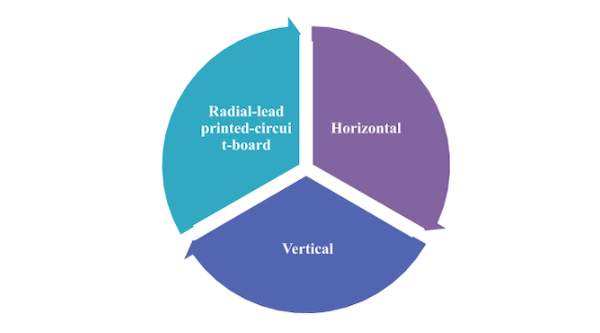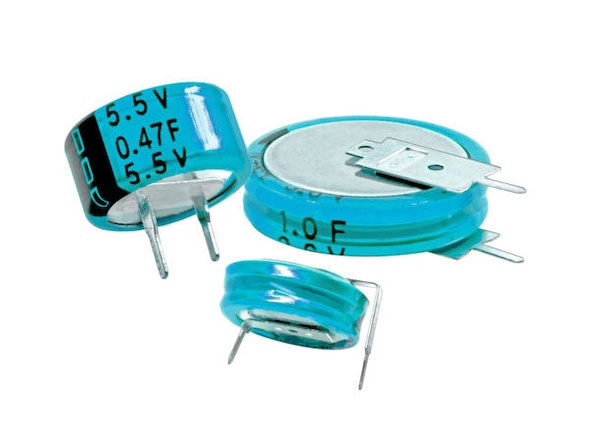These energy storage devices are designed to replace or extend battery life in onboard memory backup.
These supercapacitors store more energy and deliver greater power compared to aluminium electrolytic capacitors. Cornell Dubilier claims that these supercapacitors are not susceptible to degradation over millions of charge-discharge cycles. Packaged in through-hole stacked coin design, EDC and EDS supercapacitors provide high-density power with rapid charge and discharge times (only a few seconds).
Construction
Cornell Dubilier’s EDC and EDS supercapacitors comprise activated carbon electrodes. The electrolyte can be aqueous or non-aqueous. Unlike standard capacitors, they have no dielectric. EDC/EDS are double-layer capacitors which means the energy is stored at the interface of the carbon electrolyte. EDC and EDS supercapcitors are RoHS-compliant products.
Specifications and Features
The EDC supercapacitors have working voltages ranging from 5.5Vdc to 6.3Vdc, capacitances from 0.047F to 1.5F, and operating temperatures between -25 and +70°C. To perform a Life test of these supercapacitors, the maximum operating voltage should be applied at +70°C for 1000 hours. Similarly, to find the shelf life, the supercapacitors should be subjected to 1000 hours with no voltage at +70°C.
EDS supercapacitors have working voltages ranging from 3.6Vdc to 5.5Vdc, capacitances from 0.047F to 1.5F and operating temperatures between –25 ºC to +85 ºC. To perform a Life test of these supercapacitors, the maximum operating voltage should be applied at +85°C for 1000 hours. To find the shelf life, the supercapacitors should be subjected to 1000 hours with no voltage at +85 ºC.

Three case configurations of EDC and EDS supercapacitors. Image Credit: Cornell Dubilier.
Cornell Dubilier (CDE) has released its EDC and EDS series coin cell styled electric double-layer (EDLC) supercapacitors. These energy storage devices are designed to replace or extend battery life in onboard memory backup.
These supercapacitors store more energy and deliver greater power compared to aluminium electrolytic capacitors. Cornell Dubilier claims that these supercapacitors are not susceptible to degradation over millions of charge-discharge cycles. Packaged in through-hole stacked coin design, EDC and EDS supercapacitors provide high-density power with rapid charge and discharge times (only a few seconds).
Construction
Cornell Dubilier’s EDC and EDS supercapacitors comprise activated carbon electrodes. The electrolyte can be aqueous or non-aqueous. Unlike standard capacitors, they have no dielectric. EDC/EDS are double-layer capacitors which means the energy is stored at the interface of the carbon electrolyte. EDC and EDS supercapcitors are RoHS-compliant products.
Specifications and Features
The EDC supercapacitors have working voltages ranging from 5.5Vdc to 6.3Vdc, capacitances from 0.047F to 1.5F, and operating temperatures between -25 and +70°C. To perform a Life test of these supercapacitors, the maximum operating voltage should be applied at +70°C for 1000 hours. Similarly, to find the shelf life, the supercapacitors should be subjected to 1000 hours with no voltage at +70°C.
EDS supercapacitors have working voltages ranging from 3.6Vdc to 5.5Vdc, capacitances from 0.047F to 1.5F and operating temperatures between –25 ºC to +85 ºC. To perform a Life test of these supercapacitors, the maximum operating voltage should be applied at +85°C for 1000 hours. To find the shelf life, the supercapacitors should be subjected to 1000 hours with no voltage at +85 ºC.

EDC/EDS coin cell supercapacitors. Image Credit: Cornell Dubilier.
Benefits to Electrical Engineers
Cornell Dubilier EDC/EDS coin cell supercapacitors offer the following benefits over li-ion batteries and standard capacitors for engineering applications:
Small Footprint
EDC/EDS coin cell supercapacitors come in compact dimensions and packaging. This makes them ideal for space-constrained applications.
Higher Energy Storage and Power Delivery
Electric double-layer capacitors can store more energy and deliver greater power than batteries and capacitors.
Flexible Design
Due to their compact sizes and packaging, these products are suitable for a wide range of designs.
Long-Life
EDC/EDS coin cell supercapacitors ensure reliable operation over millions of charge-discharge cycles with no observable degradation over the period.
Augments or Replaces Existing Battery Storage
When paired in parallel with batteries, the EDC/EDS supercapacitors reduce demand for battery power by providing quick, short bursts of energy to the load. In this way, the life of the battery is extended and the overall cost of the energy system is reduced.
Applications
Some applications of EDC/EDS coin cell supercapacitors include:
-
Instantaneous Memory Backup Power: During power outages, EDC/EDS supercapacitors provide Real-Time Clock (RTC) backup power to sustain memory without batteries.
-
Internet of Things (IoT): EDC/EDS supercapacitors provide portable energy storage and harvesting for IoT applications.
-
Solar lights
-
Industrial electronics
-
Smart utility meters (AMR)
-
Telematics
-
Industrial controls





